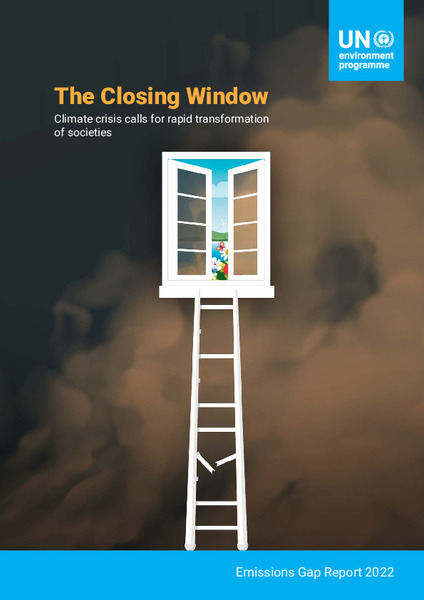Emissions Gap Report 2022: The Closing Window - Climate Crisis Calls for Rapid Transformation of Societies

Date
2022-10Author
United Nations Environment Programme
Citation Tool
Bibliographic Managers
RT Generic T1 Emissions Gap Report 2022: The Closing Window - Climate Crisis Calls for Rapid Transformation of Societies A1 United Nations Environment Programme YR 2022-10 LK https://wedocs.unep.org/20.500.11822/40874 PB AB TY - GEN T1 - Emissions Gap Report 2022: The Closing Window - Climate Crisis Calls for Rapid Transformation of Societies AU - United Nations Environment Programme Y1 - 2022-10 UR - https://wedocs.unep.org/20.500.11822/40874 PB - AB - @misc{20.500.11822_40874 author = {United Nations Environment Programme}, title = {Emissions Gap Report 2022: The Closing Window - Climate Crisis Calls for Rapid Transformation of Societies}, year = {2022-10}, abstract = {}, url = {https://wedocs.unep.org/20.500.11822/40874} } @misc{20.500.11822_40874 author = {United Nations Environment Programme}, title = {Emissions Gap Report 2022: The Closing Window - Climate Crisis Calls for Rapid Transformation of Societies}, year = {2022-10}, abstract = {}, url = {https://wedocs.unep.org/20.500.11822/40874} } TY - GEN T1 - Emissions Gap Report 2022: The Closing Window - Climate Crisis Calls for Rapid Transformation of Societies AU - United Nations Environment Programme UR - https://wedocs.unep.org/20.500.11822/40874 PB - AB -View/Open
Item Statistics
Display item statisticsMetadata
Show full item recordDescription
This thirteenth edition of the Emissions Gap Report is a testimony to inaction on the global climate crisis. In just eight years, global GHG emissions must be reduced by 30 to 45 per cent compared to where they are headed under policies currently in place to get on track to limiting global warming to well below 2.0°C and 1.5°C respectively. Commitments by countries as expressed in their latest unconditional and conditional nationally determined contributions (NDCs) for 2030 will only reduce global emissions by 5 to 10 per cent, assuming that they are fully implemented. The report looks at transformations required in electricity supply, industry, transport, buildings, food systems and the financial system.
The report i) assesses the trends in global GHG emissions, including the effects of COVID-19, and considers consumption-based emissions and their distribution between and within countries; ii) provides an updated global landscape of NDCs and long-term net-zero emissions pledges, and assesses the progress of G20 members towards achieving their NDCs and net-zero emissions pledges; iii) updates the assessment of the emissions gap by 2030 based on the latest NDCs, and considers the implications of the emissions gap on the feasibility of achieving the long-term temperature goal of the Paris Agreement; iv) provides the status of the transformation towards zero GHG emissions in the sectors of electricity supply, industry, transportation and buildings, and identifies actor-based actions that could accelerate the transformation; v) provides an assessment of the food systems transformations needed, whether there are signs that they are happening, and how they could be accelerated; and vi) considers the transformations of the finance system needed to enable the achievement of the Paris Agreement.
Collections
Item Chapters
Document Viewer
To read more, scroll down below.

